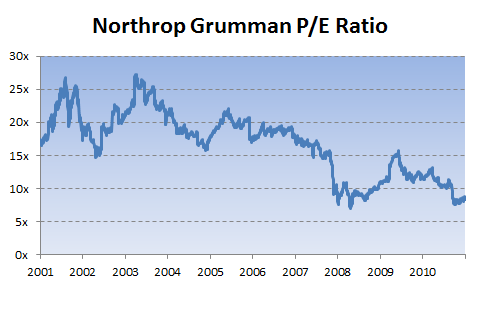A Brief History of Northup Grumman's Returns
Despite constant attempts by analysts and the media to complicate the basics of investing, there are only three ways a stock can create value for shareholders:
Dividends.
Earnings growth.
Changes in valuation multiples.
In this series, we drill down on one company's returns to see how each of those three has played a role over the past decade. Step on up, Northrop Grumman (NYS: NOC) .
Northrop shares returned 63% over the last decade. How'd they get there?
Dividends are owed most of the credit. Without dividends, shares returned just 18% over the last 10 years.
Earnings growth was fairly strong. Northrop's normalized earnings per share grew at an average rate of 8.9% per year from 2001 until today. That's well above the market average, and highlights a key aspect of the company's business model noted in its annual report: "We conduct most of our business with the U.S. Government." It's nice doing business with one customer that's impervious to budget control.
But if Northrop's earnings were so strong, why were shareholder returns relatively weak? This chart explains it:

Source: S&P Capital IQ.
Northrop's valuation multiple has plunged by about half over the last 10 years. That's prevented a good amount of its earnings growth from translating into shareholder returns.
The same has been true for General Dynamics (NYS: GD) and Lockheed Martin (NYS: LMT) . Part of the fall is simply due to shares being overvalued a decade ago. But part is the other side of doing business with the government: Being beholden to one customer -- especially one customer with unsustainable deficits -- can be devastating when that customer cuts back.
The question now is whether current valuations have already priced in impending defense cutbacks. At eight times earnings, that's likely the case for Northrop. The past decade stifled returns as valuation multiples fell. The coming decade could see the opposite, with stable or even rising valuations rewarding patient investors.
Why is this stuff worth paying attention to? It's important to know not only how much a stock has returned, but where those returns came from. Sometimes earnings grow, but the market isn't willing to pay as much for those earnings. Sometimes earnings fall, but the market bids shares higher anyway. Sometimes both earnings and earnings multiples stay flat, but a company generates returns through dividends. Sometimes everything works together, and returns surge. Sometimes nothing works and they crash. All tell a different story about the state of a company. Not knowing why something happened can be just as dangerous as not knowing that something happened at all.
Add Northrop Grumman to My Watchlist.
At the time thisarticle was published Fool contributor Morgan Housel doesn't own shares in any of the companies mentioned in this article. Follow him on Twitter @TMFHousel. The Motley Fool owns shares of Northrop Grumman, General Dynamics, and Lockheed Martin. Try any of our Foolish newsletter services free for 30 days. We Fools may not all hold the same opinions, but we all believe that considering a diverse range of insights makes us better investors. The Motley Fool has a disclosure policy.
Copyright © 1995 - 2011 The Motley Fool, LLC. All rights reserved. The Motley Fool has a disclosure policy.

